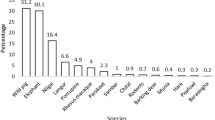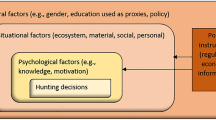Abstract
Participatory policies for natural resource management and poverty reduction have been implemented worldwide. Inclusive participation and empowerment potentially enhances intrinsic motivation to conserve resources. However, whether participation in activities for poverty reduction enhances intrinsic motivation for resource conservation is unknown. We evaluate the impact of participation, in activities to develop sustainable livelihoods, on the intrinsic motivation of forest-dwelling community members to conserve forest commons. As a component of Brazil’s Bolsa Floresta programme, these activities involve decision making, skills training and knowledge exchange related to sustainable livelihoods. Using a framed common-pool resource game with 160 community members in Amazonas State, we measure intrinsic motivation via members’ extent of cooperation in conservation of trees. We obtain an estimate of impact by exploiting a natural experiment, whereby the treatment group was offered the choice to participate in activities to develop sustainable livelihoods. We find that participation crowds in cooperative behaviour and, hence, intrinsic motivation to conserve forest commons. This result suggests that enabling participation and empowering community members in the development of sustainable livelihoods has a positive effect on conservation behaviour. Our results have critical implications for participatory policies with dual environment–development goals in settings where policy recipients are marginalized.
This is a preview of subscription content, access via your institution
Access options
Access Nature and 54 other Nature Portfolio journals
Get Nature+, our best-value online-access subscription
$29.99 / 30 days
cancel any time
Subscribe to this journal
Receive 12 digital issues and online access to articles
$119.00 per year
only $9.92 per issue
Buy this article
- Purchase on Springer Link
- Instant access to full article PDF
Prices may be subject to local taxes which are calculated during checkout


Similar content being viewed by others
Data availability
The data that support the findings of this study are available from the corresponding author upon request.
References
Engel, S., Palmer, C. & Pfaff, A. On the endogeneity of resource comanagement: theory and evidence from Indonesia. Land Econ. 89, 308–329 (2013).
Mansuri, G. & Rao, V. Localizing Developing: Does Participation Work? (World Bank, 2013).
Arnstein, S. R. A ladder of citizen participation. J. Am. Inst. Plann. 35, 216–224 (1969).
Reed, M. S. Stakeholder participation for environmental management: a literature review. Biol. Conserv. 141, 2417–2431 (2008).
Coleman, E. A. & Fleischman, F. D. Comparing forest decentralization and local institutional change in Bolivia, Kenya, Mexico, and Uganda. World Dev. 40, 836–849 (2012).
Rustagi, D., Engel, S. & Kosfeld, M. Conditional cooperation and costly monitoring explain success in forest commons management. Science 330, 961–965 (2010).
Spreitzer, G. M. Individual empowerment in the workplace: dimensions, measurement, validation. Acad. Manage. J. 38, 1442–1465 (1995).
Zhang, X. & Bartol, K. M. Linking empowering leadership and employee creativity: the influence of psychological empowerment, intrinsic motivation, and creative process engagement. Acad. Manage. J. 53, 108–128 (2010).
Gómez-Baggethun, RodeJ. & Krause, T. Motivation crowding by economic incentives in conservation policy: a review of the empirical evidence. Ecol. Econ. 117, 270–282 (2015).
Ezzine-de-Blas, CorberaE. & Lepeyre, R. Payments for environmental services and motivational crowding: towards a conceptual framework. Ecol. Econ. 156, 434–443 (2019).
Cárdenas, J. C. Human behaviour and the use of experiments to understand the agricultural, resource, and environmental challenges of the XXI century. Agric. Econ. 47, 61–71 (2016).
Cárdenas, J. C., Stranlund, J. & Willis, C. Local environmental control and institutional crowding-out. World Dev. 28, 1719–1733 (2000).
Vollan, B. Socio-ecological explanations for crowding-out effects from economic field experiments in southern Africa. Ecol. Econ. 67, 560–573 (2008).
Andersson, K. P. et al. Experimental evidence on payments for forest commons conservation. Nat. Sustain. 1, 128–135 (2018).
Kaczan, D. J., Swallow, B. M. & Adamowicz, W. L. Forest conservation policy and motivational crowding: Experimental evidence from Tanzania’. Ecol. Econ. 156, 444–453 (2018).
Dedeurwaerdere, T. J. et al. Combining internal and external motivations in multi-actor governance arrangements for biodiversity and ecosystem services. Environ. Sci. Policy 58, 1–10 (2016).
Fundação Amazonas Sustentável Relatório de Atividades 2018 https://drive.google.com/file/d/1sqwdTWI4KXMpLfk36p_ADzC2Hpu1kkOW/view (2018).
Ferraro, P. & Simpson, D. The cost-effectiveness of conservation payments. Land Econ. 78, 339–353 (2002).
Groom, B. & Palmer, C. Cost-effective provision of environmental services: the role of relaxing market constraints. Env. Dev. Econ. 15, 219–240 (2010).
Deci, E. L. & Ryan, R. M. in Nebraska Symposium on Motivation: Perspectives on Motivation 38 (ed. Dienstbier, R.) 237–288 (Univ. of Nebraska Press, 1991).
Ryan, R. M. & Deci, E. L. Self-determination theory and the facilitation of intrinsic motivation, social development, and well-being. Am. Psychol. 55, 68–78 (2000).
Bauer, M. et al. Can war foster cooperation? J. Econ. Perspect. 30, 249–274 (2016).
Fabbri, M. How Institutions Shape Preferences: Experimental Evidence from a Large-scale Property Rights Reform Implemented as Randomized Control-trial http://hdl.handle.net/1765/104965 (2017).
Cragg, J. G. Some statistical models for limited dependent variables with application to the demand for durable goods. Econometrica 39, 829–844 (1971).
Bound, J., Jaeger, D. A. & Baker, R. M. Problems with instrumental variables estimation when the correlation between the instruments and the endogenous explanatory variable is weak. J. Am. Stat. Assoc. 90, 443–450 (1995).
Bouma, J., Reyes-García, V., Huanca, T. & Arrazola, S. Understanding conditions for co-management: a framed field experiment amongst the Tsimane, Bolivia. Ecol. Econ. 141, 32–42 (2017).
Bowles, S. & Polania-Reyes, S. Economic incentives and social preferences: substitutes or complements? J. Econ. Lit. 50, 368–425 (2012).
Bardhan, P. Decentralization of governance and development. J. Econ. Perspect. 16, 185–205 (2002).
Andersson, K. & Agrawal, A. Inequalities, institutions, and forest commons. Glob. Environ. Change 21, 866–875 (2011).
Ostrom, E. Governing the Commons: The Evolution of Institutions for Collective Action (Cambridge Univ. Press, 1990).
Baland, J.-M. & Platteau, J.-P. Halting Degradation of Natural Resources: Is There a Role for Rural Communities? (FAO, 1996).
Ostrom, E., Gardner, R. & Walker, J. Rules, Games, and Common-pool Resources (Univ. of Michigan Press, 1994).
Sally, D. Can I say ‘bobobo’ and mean ‘There’s no such thing as cheap talk’. J. Econ. Behav. Organ. 57, 245–266 (2005).
Souza, G. I. People, Parks, and Public Policies in the Twenty-First Century. Human Security and the Political Ecologies of the Brazilian Amazon. Reflections from the Mosaic of Protected Areas of the Lower River Negro, Amazonas (King’s Brazil Institute, 2017).
Ostrom, E. Collective action and the evolution of social norms’. J. Econ. Perspect. 14, 137–158 (2000).
Fischbacher, U., Gächter, S. & Fehr, E. Are people conditionally cooperative? Evidence from a Public Goods experiment. Econ. Lett. 71, 397–404 (2001).
Keser, C. & van Winden, F. Conditional cooperation and voluntary contributions to public goods. Scand. J. Econ. 102, 23–39 (2000).
Gupta, S. K. Intention-to-treat concept: a review. Perspect. Clin. Res. 2, 109–112 (2011).
Battese, G. E. A note on the estimation of Cobb–Douglas production functions when some explanatory variables have zero values. J. Agric. Econ. 48, 250–252 (1997).
QGIS Development Team QGIS Geographic Information System v.2.18 (Open Source Geospatial Foundation Project, 2016); http://qgis.osgeo.org
Acknowledgements
For helpful discussions and comments we thank J. Bouma, B. Groom, E. Gsottbauer, A. Kontoleon, A.-K. Koessler, L. Lima, R. Lubowski, M. Malen, S. Roth, V. Salviatti, G. Shreedhar and V. Solidade; participants at the Sustainability and Development Conference (Michigan), BIOECON (Wageningen); and research seminars at Cambridge University, Hamburg University and the LSE. We also thank our research assistants (A. Ferreira, C. França, T. Farias, A. de Carvalho, E. Mota, L. Barros, L. M. Ferreira, M. Leitão and R. J. da Costa) in the Institutional Links project ‘Participatory Approaches to Natural Resource Conservation in the Brazilian Amazon’, funded by the British Council (Newton Fund, grant no. 261873660 (SSP-C577)). The FAS provided further funding and logistical assistance. This article is dedicated to the memory of T. Hall, who sadly passed away in May 2019.
Author information
Authors and Affiliations
Contributions
A.H., V.V. and C.P. conceived the project. C.P and G.I.S. designed the experiment, household survey and interview questions. G.I.S., E.L. and C.P. conducted the experiments. G.I.S. and E.L. conducted the interviews. C.P. developed the analytical approach, analysed the data and wrote the paper.
Corresponding author
Ethics declarations
Competing interests
The authors declare no competing interests.
Additional information
Publisher’s note Springer Nature remains neutral with regard to jurisdictional claims in published maps and institutional affiliations.
Supplementary information
Supplementary Information
Supplementary discussion, methods, Tables 1–14, Figs. 1–4 and references.
Rights and permissions
About this article
Cite this article
Palmer, C., Souza, G.I., Laray, E. et al. Participatory policies and intrinsic motivation to conserve forest commons. Nat Sustain 3, 620–627 (2020). https://doi.org/10.1038/s41893-020-0531-8
Received:
Accepted:
Published:
Issue Date:
DOI: https://doi.org/10.1038/s41893-020-0531-8



